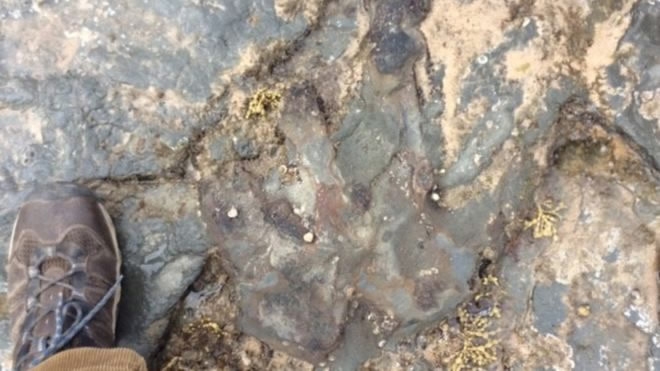
World
16:05, 21-Dec-2017
115-million-year-old dinosaur footprint damaged in Australian national park
CGTN

At a national park in Australia, an ancient footprint left by a theropod dinosaur some 115 million years ago has found to have been partially destroyed by vandals, who are believed to have conducted the sabotage with a hammer.
The damage on the one-foot wide print was spotted last week while a school group was on a tour of the park, which is east of Melbourne.
Authorities believe the unidentified perpetrators used a hammer to chip away the three-toed mark of a medium-sized theropod since “freshly broken” fragments were scattered around the broken footprint.

The ancient dinosaur footprint was partially destroyed. /Parks Victoria Photo
The ancient dinosaur footprint was partially destroyed. /Parks Victoria Photo
“It’s a popular, significant site. The rock there is reasonably hard so it looks like it's been hit with a hammer and pieces of the rock around the edge of the footprint have been broken away,” Parks Victoria ranger Brian Martin said in an interview with ABC News.
Found in 2006 at a tidal rock platform at Flat Rocks in Victoria state - an area rich in dinosaur fossil bones and teeth - the 30 cm-wide mark was left open-air instead of being restored with silicone rubber inside museums in a bid to allow tourists to visit it in its natural state.

The footprint was usually left unattended by tourists in the rock. /AFP Photo
The footprint was usually left unattended by tourists in the rock. /AFP Photo
According to Martin, the vandals had deliberately targeted the footprint since it was usually left unattended by negligent tourists due to being embedded in the rock.
“They would need to know exactly where it is to find it, many people quite easily walk right past it,” Martin revealed to BBC.
While the saboteurs have yet to be found, park authorities have already wished to repair the partially destroyed footprint because of its “international scientific significance” in representing a “moment frozen in time, when a meat-eating dinosaur stood on that spot,” according to Martin.

The footprint has international scientific significance for representing “a moment frozen in time when a meat-eating dinosaur stood on that spot” according to Parks Victoria ranger Brian Martin. /AFP Photo
The footprint has international scientific significance for representing “a moment frozen in time when a meat-eating dinosaur stood on that spot” according to Parks Victoria ranger Brian Martin. /AFP Photo
“Fortunately, I was able to retrieve some of the broken pieces of the footprint and hopefully the technicians at Museum Victoria may be able to restore the footprint to some degree,” Mike Cleeland, a paleontologist from the Bunurong Environment Center told local media while slamming the “callous act of vandalism”.
(With inputs from agencies)

SITEMAP
Copyright © 2018 CGTN. Beijing ICP prepared NO.16065310-3
Copyright © 2018 CGTN. Beijing ICP prepared NO.16065310-3